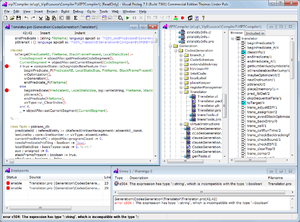Visual Prolog
|
IDE Screenshot | |
| Developer(s) | Prolog Development Center |
|---|---|
| Stable release |
7.5, Build 7502
/ November 5, 2015 |
| Operating system | MS Windows Vista/Windows 7/Windows 8 |
| Type | Programming language |
| License | Proprietary |
| Website |
www |
Visual Prolog, also formerly known as PDC Prolog and Turbo Prolog, is a strongly typed object-oriented extension of Prolog. As Turbo Prolog it was marketed by Borland, but it is now developed and marketed by the Danish firm Prolog Development Center (PDC) that originally developed it. Visual Prolog can build Microsoft Windows GUI-applications, console applications, DLLs (dynamic link libraries), and CGI-programs. It can also link to COM components and to databases by means of ODBC.
Logic languages are traditionally interpreted, but Visual Prolog is compiled. This provides the important improvement of converting traditional Prolog-typical run-time errors to compiler warnings, which ensures a better robustness of the finished applications.
The core of Visual Prolog are Horn clauses, algebraic datatypes, pattern matching and controlled non-determinism like in traditional Prolog, but unlike traditional Prolog, Visual Prolog has always been strongly and statically typed.
Brief Release History
Version 7.5 contains http server and LALR(1) parser generator (see also New Features in Visual Prolog 7.5).
Version 7.4 can generate 64 bit windows code (see also New Features in Visual Prolog 7.4).
Version 7.3 introduced generic classes and interfaces (see Generic programming), guarded monitors (see also New Features in Visual Prolog 7.3).
Version 7.2 introduced anonymous predicates (a logical pendant to anonymous functions) and namespaces (see also New Features in Visual Prolog 7.2).
Version 7.0 introduced parametric polymorphism.
Since version 6.0 the language has been fully object-oriented.
Hanoi Example
In the 'Towers of Hanoi' example, the Prolog inference engine figures out how to move a stack of any number of progressively smaller disks, one at a time, from the left ('left') pole to the right pole ('right') in the described way, by means of a center ('center') pole as transit, so that there's never a bigger disk on top of a smaller disk. The predicate 'hanoi' takes an integer = the number of disks, as an initial argument. In real-life, Visual Prolog is especially suited for intricate problems, such as resource planning, etc. As the example shows, Visual Prolog can be used for quick 'programming in the small,' but it is mostly employed for industrial-strength large applications.
class hanoi
predicates
hanoi : (unsigned N).
end class hanoi
implement hanoi
domains
pole = string.
clauses
hanoi(N) :- move(N, "left", "centre", "right").
class predicates
move : (unsigned N, pole A, pole B, pole C).
clauses
move(0, _, _, _) :- !.
move(N, A, B, C) :-
move(N-1, A, C, B),
stdio::writef("move a disc from % pole to the % pole\n", A, C),
move(N-1, B, A, C).
end implement hanoi
goal
console::init(),
hanoi::hanoi(4).
Visual Prolog Video Tutorials
- Hello World! | Visual Prolog | Video Tutorial demonstrates basic IDE features while creating a "Hello World!" program.
- Form Demo | Visual Prolog | Video Tutorial demonstrates how to create a form and link it to a menu item.
- IntelliSpeed | Visual Prolog | Video Tutorial demonstrates the autocompletion facility in the IDE.
Books about Visual Prolog
- Thomas W. de Boer, A Beginners Guide to Visual Prolog
- Eduardo Costa, Visual Prolog for Tyros
- Giovanni Torrero, VISUAL PROLOG PER PRINCIPIANTI Italian 113 pages (pdf)
- Randall Scott, A Guide to Artificial Intelligence with Visual Prolog, ISBN 978-1-4327-4936-1
See also
- Logtalk, object-oriented
- Mercury (programming language), static and strong typing
